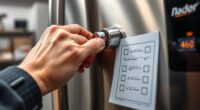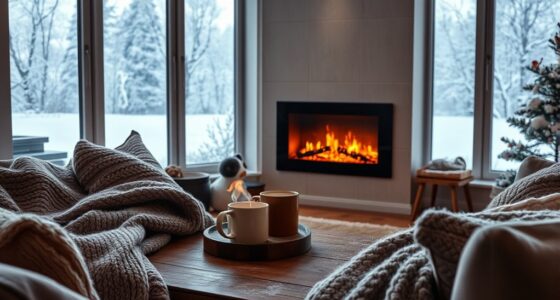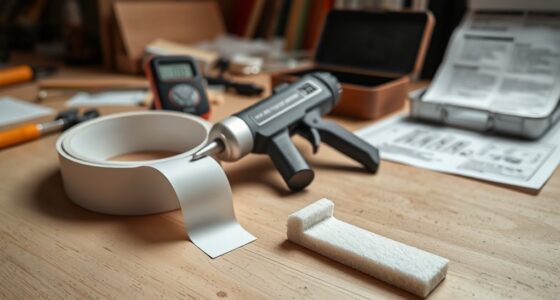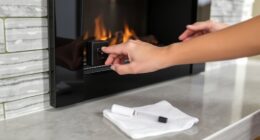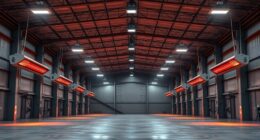To avoid hidden costs like moisture damage, mold, and higher energy bills, make certain you prioritize proper ventilation and moisture control. Choose insulation materials suited for your climate, and don’t skip professional assessment and installation to guarantee everything is fitted correctly. Regular inspections and maintenance catch issues early before they lead to costly repairs. If you follow these steps, you’ll protect your home and save money in the long run. Keep going to learn more.
Key Takeaways
- Poor ventilation and moisture control can cause hidden mold, wood rot, and insulation damage over time.
- Using inappropriate insulation materials leads to inefficiency, moisture retention, and potential structural issues.
- DIY installation risks gaps and uneven coverage, reducing insulation effectiveness and increasing hidden costs.
- Neglecting regular inspections allows small issues like gaps or moisture buildup to escalate into costly repairs.
- Ignoring proper assessment and maintenance increases long-term expenses due to hidden damage and decreased energy efficiency.
Overlooking Proper Ventilation and Moisture Control

Even if you invest in high-quality insulation, neglecting proper ventilation and moisture control can undermine your efforts. Without adequate ventilation gaps, moisture can accumulate inside your walls and attic, leading to moisture buildup. This trapped moisture promotes mold growth, wood rot, and reduces insulation effectiveness. Proper ventilation ensures a continuous airflow that helps regulate temperature and remove excess humidity. Installing ventilation gaps strategically allows moisture to escape and fresh air to circulate. Ignoring these steps leaves your home vulnerable to hidden damage, which can increase repair costs and decrease energy efficiency. Effective moisture management is essential to prevent long-term structural issues. To avoid these issues, always incorporate sufficient ventilation and moisture control measures alongside your insulation. This balanced approach keeps your home dry, healthy, and insulated effectively.
Choosing Inappropriate Insulation Materials

Selecting the wrong insulation materials can undermine the efforts you’ve made to improve your home’s energy efficiency. Choosing incompatible insulation material impacts thermal performance, leading to heat loss or build-up. For example, opting for fiberglass in damp areas causes moisture retention, reducing effectiveness. Similarly, using spray foam in areas prone to pests can create issues. To avoid costly mistakes, consider these factors:
| Insulation Material | Thermal Performance | Best Use Case |
|---|---|---|
| Fiberglass | Moderate | Attics, walls |
| Spray Foam | High | Cracks, gaps |
| Mineral Wool | Good | Fire-resistant areas |
| Reflective Foil | Low to Moderate | Radiant barriers |
| Cellulose | Moderate to High | Wall cavities |
Choosing the right insulation material ensures appropriate thermal performance and long-term savings. Additionally, understanding the compatibility of materials with your climate and home structure can prevent future issues.
Skipping Professional Assessment and Installation

Skipping a professional assessment and installation can lead to significant energy inefficiencies and costly mistakes. DIY pitfalls often tempt homeowners to save money, but improper insulation installation can cause gaps, compression, or uneven coverage, reducing effectiveness. Without expert evaluation, you might select the wrong materials or underestimate the amount needed, resulting in waste and higher expenses. Poor installation can also cause air leaks, moisture problems, and even structural issues. These mistakes compromise your home’s heat retention, increasing energy bills and decreasing comfort. Investing in professional assessment ensures proper material choice and precise installation, avoiding these costly errors. Proper airless paint sprayer techniques and equipment can also help ensure optimal coverage and efficiency. While it may seem like an added expense upfront, professional help ultimately saves you money and energy by guaranteeing your insulation functions at its best.
Neglecting Regular Inspection and Maintenance

Neglecting regular inspection and maintenance can cause small issues to escalate into costly problems over time. Overlooking signs of thermal bridging or insulation gaps allows heat to escape and cold spots to develop, reducing your home’s efficiency. Without routine checks, damaged or displaced insulation may go unnoticed, leading to increased energy bills. Gaps in insulation can also promote moisture buildup, risking mold growth and structural damage. Regular inspections help identify these issues early, so you can seal gaps, reinforce insulation, and prevent heat loss. Additionally, neglecting detailed assessments may overlook underlying issues such as insulation degradation, which can compromise overall thermal performance. By maintaining your insulation system, you guarantee ideal heat retention and avoid the high costs associated with major repairs caused by neglect. Staying proactive saves money and keeps your home comfortable year-round.
Frequently Asked Questions
How Can Poor Ventilation Impact Insulation Effectiveness?
Poor ventilation can considerably reduce insulation’s effectiveness by causing moisture buildup and ventilation issues. When air isn’t circulating properly, humidity levels rise, leading to condensation within your insulation. This moisture can degrade insulation materials, making them less efficient and increasing the risk of mold growth. To avoid this, make sure proper airflow through vents and exhaust fans, which helps control moisture, maintain insulation performance, and promote a healthier indoor environment.
What Signs Indicate Insulation Material Is Unsuitable?
You’ll notice insulation material is unsuitable if you see moisture buildup or dust accumulation on surfaces nearby. These signs indicate poor moisture control and inadequate filtration, which can lead to mold growth and reduced insulation efficiency. Additionally, if you experience persistent drafts or uneven temperatures, it’s a clear sign that your insulation isn’t performing well. Addressing these issues promptly helps guarantee your insulation remains effective and maintains a healthy indoor environment.
How Often Should Professional Assessments Be Scheduled?
You should schedule professional assessments at least once every 3 to 5 years to guarantee your insulation remains effective. Regular inspection frequency helps catch issues early and maintains peak heat retention. If you notice significant drafts, rising energy bills, or insulation damage, consider more frequent assessments. Proper assessment timing keeps your home energy-efficient, prevents hidden costs, and extends the lifespan of your insulation system.
What Maintenance Tasks Prevent Insulation Degradation?
You should regularly inspect your insulation for signs of damage or moisture buildup, guaranteeing thermal barriers stay effective. Keep moisture control in mind by sealing leaks and vents to prevent dampness, which can degrade insulation over time. Additionally, clear debris from vents and ensure proper ventilation to avoid mold and mildew. These maintenance tasks help preserve your insulation’s effectiveness, extend its lifespan, and maintain ideal heat retention in your home.
Are There Eco-Friendly Insulation Options to Consider?
It turns out, eco-friendly materials like cellulose, sheep’s wool, and recycled denim make excellent choices for green insulation. You can opt for green insulation options that reduce environmental impact while providing effective heat retention. These materials not only minimize your carbon footprint but also promote healthier indoor air quality. By choosing eco-friendly options, you’re supporting sustainable building practices and ensuring your home stays warm efficiently and responsibly.
Conclusion
So, next time you decide to insulate without thinking, remember: a little moisture or poor ventilation can turn your cozy home into a moldy disaster. Skipping professional advice might save a buck, but it’ll cost you more in the long run. Regular checks? Who needs those? Just sit back and enjoy your beautifully hidden, yet secretly costly, insulation blunders. After all, a little oversight now guarantees a delightful surprise later!

